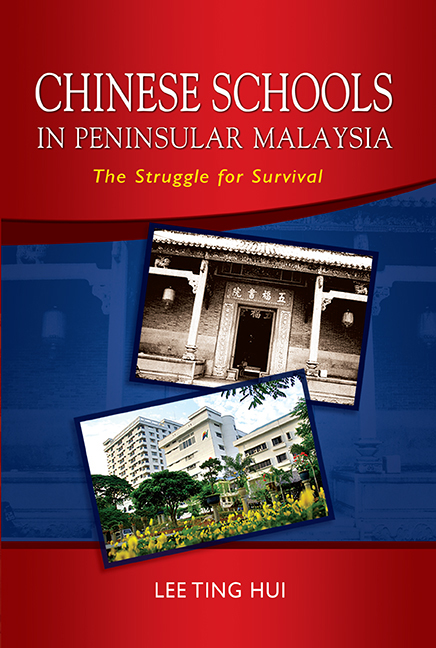Book contents
- Frontmatter
- Contents
- Acknowledgements
- Abbreviations
- Notes on Coverage and Names
- Introduction
- 1 The Years before the Pacific War
- 2 From the Japanese Occupation to Self-Government
- 3 Towards the “Ultimate Objective” of One-medium Education
- 4 One-medium Education under Rukun Negara and the New Economic Policy
- 5 The 1980s: A Decade of Continuing Challenges for the Chinese Schools
- 6 Vision 2020 and the Chinese Schools
- 7 Conclusion: Challenges and Responses
- Glossary
- Bibliography
- Index
- About the Author
7 - Conclusion: Challenges and Responses
Published online by Cambridge University Press: 21 October 2015
- Frontmatter
- Contents
- Acknowledgements
- Abbreviations
- Notes on Coverage and Names
- Introduction
- 1 The Years before the Pacific War
- 2 From the Japanese Occupation to Self-Government
- 3 Towards the “Ultimate Objective” of One-medium Education
- 4 One-medium Education under Rukun Negara and the New Economic Policy
- 5 The 1980s: A Decade of Continuing Challenges for the Chinese Schools
- 6 Vision 2020 and the Chinese Schools
- 7 Conclusion: Challenges and Responses
- Glossary
- Bibliography
- Index
- About the Author
Summary
From the first day, when the first old-style school was founded in Penang in 1819, until 2007, Chinese schools in Malaysia have undergone a development of more than 180 years. According to statistics, in 2007, there were 1,289 Chinese primary schools with 643,679 pupils in the country; in 2005, there were 78 National-Type Secondary Schools with 128,459 students; and in 2007, there were 60 independent Chinese secondary schools with 55,818 students. In the tertiary field of education, in 2007, there were the Southern College in Johor, the New Era College in Selangor, and the Han Jiang International College in Penang. Such results were achieved only after serious challenges were met and great sacrifices made in the course of struggle.
In this conclusion, we propose first to review briefly the salient points of what happened to these schools from 1786 to 2003, as accounted for in the last six chapters in this book, then to discuss briefly what took place from 2004 to early 2009, and finally to anticipate what these schools could expect in the near future.
1786–2003: UNITARIANISM OR PLURALISM
The British ruled Peninsular Malaysia from 1786 to 1957. After 1957, political power was transferred from the British to the local races, namely the Malays, Chinese, and Indians, with the Malays as the leading element, who then formed the government of the country. When the British were around, they gave full support to schools which used English as the main medium of instruction and some support to schools which used Malay as the main medium of instruction. They were less than forthcoming in giving assistance to schools which used Chinese or Tamil as the main medium of instruction. They could be said, by and large, to practise unitarianism. The Chinese and Tamil schools had hoped that they could be treated equally as the English and Malay schools, but they were to be disappointed. These schools believed in pluralism. For the years before the Pacific War, the important things to note were the Schools Registration Ordinance/Enactment and their subsequent amendments.
- Type
- Chapter
- Information
- Chinese Schools in Peninsular MalaysiaThe Struggle for Survival, pp. 218 - 248Publisher: ISEAS–Yusof Ishak InstitutePrint publication year: 2011



